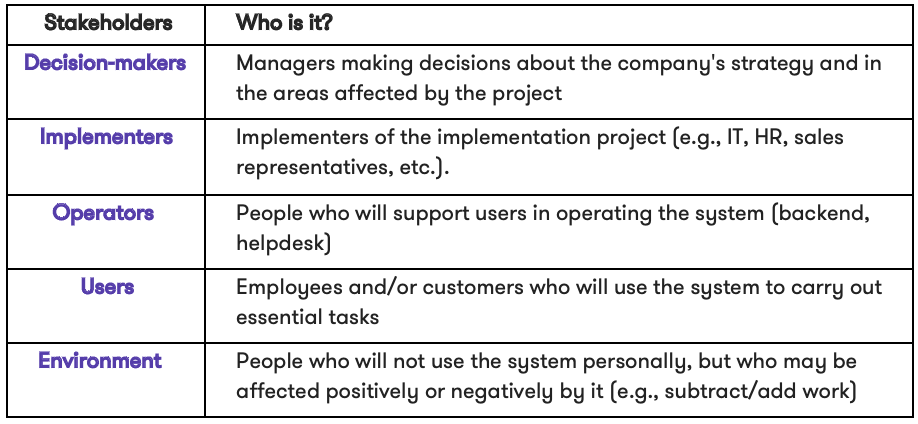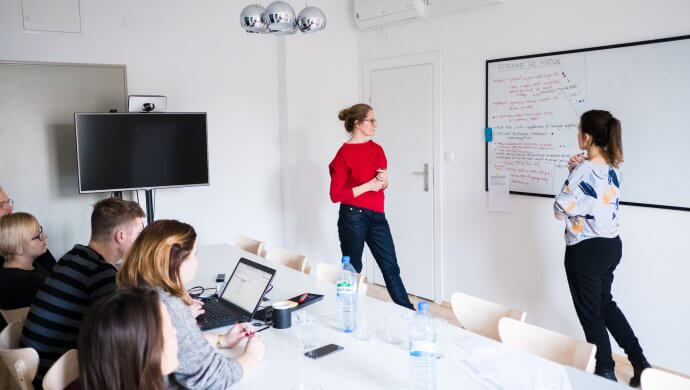Whether you are working on creating an MVP of a new digital service or product, a digital implementation, or a redesign of an existing digital solution – taking the time to clarify the goals, scope, and means of implementation saves on implementation outlay as well as corrections and risk management.
A business requirements workshop is a great way to clarify the scope of a project with key decision-makers and implementers and decide whether (or not) to hire a subcontractor or choose a digital solution provider.
What is a business requirements workshop and why do it?
A business requirements workshop is a meeting to establish the scope of a project and the conditions for an implementation to be considered a success. The workshop serves the purpose of identifying, with the participation of key decision-makers and implementers, the starting point and the optimal way to implement the project.
The workshop helps to structure knowledge about the assumptions and boundary conditions of the project or implementation. It also provides a basis for estimating the size and complexity of the project, its time consumption, and its risks.

The business requirements workshop method developed at EDISONDA is based on years of experience working with clients and design thinking tools. Its application provides our clients and us with sufficiently precise information needed to determine project feasibility and expected outcomes. The business requirements workshop is one of our core business design consultancy tools.
Participants in the workshops we ran pointed to benefits such as:
- “All the previous ideas were on paper.”
- “[Now I have] a sense of how much work is ahead of us.”
- “Getting our wants and assumptions in order, translating that into opportunities.”
How to prepare for a business requirements workshop?
An essential preparation for the workshop (and any project) is to at least pre-define what we want the product or service (MVP), the innovation, to be about, and which group we want to target with the solution. If our vision goes further, it is worth determining what budget we have and how we envisage the implementation plan.
In addition to the plan and budget, a shared understanding of the goals and scope is essential to the project. Determining at the start who will have an impact on the project at different stages and who may have the knowledge needed to properly plan and implement the project enables the necessary people and teams to be invited into the project at the right time.
It is also very useful to write down your (potential) competitors and look at their solutions and revenues. If you don’t have this knowledge, there is usually value in having a business design consultant like me provide it.
What a business requirements workshop looks like – next steps
By business objectives, in simplest terms, I mean defining how the solution has to work in order for the implementation to be considered a success by stakeholders (more on that in a moment).
Competitive advantages are those advantages and functionalities of the solution that will make the solution superior to what your company offers now and to your competitors’ offerings. In the case of a brand new solution, not yet available on the market, it is important to specify how the solution will be better than the alternatives. When identifying competitive advantages, it is worth looking at the problems and needs of stakeholders. When implementing a solution, communicating those benefits that suit your stakeholders will help your offering to be adopted more quickly by users and decision-makers.
You can read more about using user input to prepare for changes you are making here: UX research and change management. How to talk about changes so that users like them?
It is a good idea to save participants’ time by preparing a preliminary inventory of information about the project’s objectives, but it is crucial to create the conditions for active participation and frank statements from each participant in the meeting.
The findings of the meeting participants regarding the objectives of the implementation, the expected way in which the solution will work, the competitive advantages, the potential risks, as well as the implementation conditions, should be written down and included in the project documentation.
The meeting, led by an Edisonda consultant, consists of a series of exercises using an interactive online whiteboard. Each participant in the meeting has the opportunity to edit the elements of the whiteboard, add his or her own ideas, possess information, and comment. The use of techniques and exercises known from the design thinking approach helps active participation.
Before the workshop itself, the client team receives a link to the interactive whiteboard and a short introductory task from us. The completed whiteboard, with prepared comments, benchmarks, and recommendations, is available to the client team after the workshop.
Who should attend a business requirements workshop?
We primarily involve those responsible for the maintenance and development of a product or service in the workshop, as well as directors and board members responsible for a particular area of the company. Participation in a meeting of high-level executives helps to better understand expectations of the project’s outcomes, to define the conditions for acceptance, and to take into account other initiatives being implemented in the company.

The presence of people who are involved in the day-to-day maintenance of the service (both servicing users internally and providing services to external customers) helps to better understand the users’ needs and the possible problems and opportunities that the introduction of new services or functionalities will bring. Finally, the participation of people who are involved in the development of the company’s offering or infrastructure is essential to identify the company’s current digital and organisational ecosystem and the requirements they place on the new project.
Ideally, the team attending the business requirements workshop should include representatives from all stakeholder groups. Stakeholders are representatives of all groups that will be involved in the implementation or will maintain and use the implemented solution. Omitting any of the stakeholder groups usually results in implementation turbulence.

How long is the business requirements workshop?
The optimal length of the workshop is 3 hours. This length of meeting allows you to:
- gather key information regarding the aims and objectives of the project,
- check to what extent the visions and needs of individual decision-makers coincide
- to map the enablers of the business idea, potential risks, and related projects that may affect the success and speed of implementation.
In our work with EDISONDA’s clients, we use workshop scenarios developed on the basis of our long-term experience in implementing several hundred projects for Polish and foreign companies in the industries in which we operate. Each scenario consists of several exercises, lasting a total of 2 to 3 hours. We conduct the exercises using an interactive online whiteboard, which allows all participants to actively participate and submit information, ideas, and concerns, which are taken into account in the summary.
Are you taking a risk by doing a business requirements workshop with the support of an external expert?
Talking about business ideas, company goals and problems to people outside the company can seem disconcerting to some. We are revealing ourselves to someone before we decide whether we will work with them.
In some organisations, workshops as a form of arrangement are not very reputable. Some decision-makers feel that we spend time on discussions that do not result in concrete decisions.
Any concerns turn out to be overblown.
Firstly, we can sign a confidentiality clause at the client’s request before the workshop. Secondly, an outsider, by skilfully asking questions, helps to draw out what is relevant to the project and what has not necessarily already found its way into the project documentation. Thirdly, in many companies, the alternative to a meeting between the team and a management representative is to laboriously consult the project with everyone who has something to add, individually. With many projects going on simultaneously, this stretches the decision-making process too long weeks or months. A workshop of a few hours, summarised in a whiteboard report with recommendations and an offer, allows knowledge to be gathered and decisions to be made more quickly. It also helps to put the business design process in order and, in so doing, allows you to trace the premises on which decisions were based and whether the changing environment may affect the success of the project.
Participants in the workshops that I had the opportunity to moderate pointed to the benefits they achieved as a result of the business requirements workshop. These stemmed primarily from the opportunity to juxtapose an idea with the knowledge of experts, experienced in digital projects:
- “A sense of security, of support in carrying out the project”.
- “The opportunity to meet a team that knows what they are up against”.
- “Motivation to implement”.
What do you gain from the business requirements workshop?
The first and immediate effect of the workshop is to clarify the scope of the project or digital implementation. This effect is achieved by organising information about the scope of the project, the resources at hand, user and company needs, boundary conditions, and potential risk factors. This constitutes a substantial contribution to the preparation of documentation, which is important both for the implementation team and for potential subcontractors or suppliers of software and infrastructure.
The added value of inviting our consultant to lead the workshop is the expert input in the form of benchmarking, concept reviews, recommendations on technology, project organisation, or the business side of the project. The final recommendations will help you clarify the scope of the project and assess its feasibility. During the workshop, our consultant proposes solutions that we have recommended and/or designed (in other projects) to determine the client’s preferences.
In addition, thanks to the information gathered during the meeting, our team prepares an offer tailored to the needs of the organisation in question. This takes into account not only the objectives of the project but also the context of the organisation (way of working, team structure).
After the workshop, clients are given access to an interactive dashboard with a summary of the meeting and a recommendation of the next steps to be taken in the project, along with a proposed work plan.
Using this information, you will make more effective decisions on the project implementation and the final scope of work. This was expressed brilliantly by one of the directors attending our workshop:
“The workshop was needed because it opened our eyes to the enormity of this project.”




